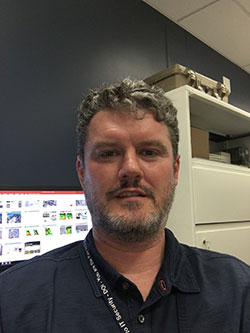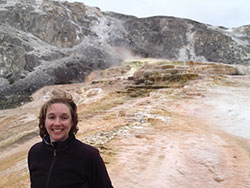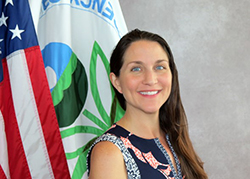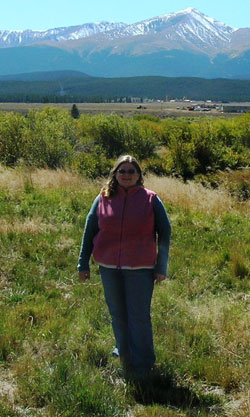FRTR Presents...Heavy Metals-Mining Site Characterization and Treatment Session 3
Sponsored by: Federal Remediation Technologies Roundtable (FRTR)
This webinar is part of a series featuring presentations delivered at the May 2017 Federal Remediation Technologies Roundtable Meeting. This meeting focused on the characterization and treatment of heavy metals at mining sites. More information about the meeting can be found at https://frtr.gov/meetings1.htm. This webinar will focus on techniques that can be implemented for site characterization and modelling. Two techniques will be presented in this webinar: (1) Best practices for monitoring and modeling to understand fundamental biogeochemical processes at metal-rich sites in order to improve conceptual and numerical models; and (2) Use of unmanned aircrafts to conduct biological surveys at mining sites.
Use of Unmanned Aircraft Systems (UAS) in BLM
Brian Hadley, Ph.D., BLM
This presentation details the Bureau of Land Management's (BLM) UAS activities, including an overview of the program objectives, current aircraft, and pilot training requirements. For nearly a decade, BLM has effectively employed UAS technology for a wide variety of natural, cultural, and paleontological resource management applications, including biological surveys (e.g., population counts), dinosaur tracksite and fossil imprint mapping, surveys of abandoned mine lands (e.g., volumetric estimates at CERCLA sites), and production verification for mining operations. Examples of data products generated from UAS platforms include ortho-imagery, digital elevation models, 3D point clouds, and full motion video.
Optimizing Remediation Approaches at Mine Sites: How Understanding Biogeochemical Processes and Modeling Can Guide AMD and In Situ Uranium Treatments
Kate Campbell Ph.D, USGS
This presentation aims to aid viewers to understand fundamental biogeochemical processes at metal-rich sites can improve conceptual and numerical models. Case studies illustrate surface and in situ groundwater treatment approaches with associated laboratory experiments, including acidic, metal-rich waters and uranium-impacted aquifers. Strong links between microbiology, mineralogy, hydrology, and water chemistry are crucial for models development applied to site management.
FRTR Heavy Metals-Mining Site Characterization and Treatment Series Archives
- ITRC PFAS Beyond the Basics: Topics on PFAS Biosolids: Sources, Transport, and Management of PFAS Surface Releases (May 20, 2025)
- ITRC: Introduction to Hydrocarbons (Apr 17, 2025)
- ITRC PFAS Beyond the Basics: PFAS Human Health, Ecological Effects and Regulations (Mar 25, 2025)
- ITRC: Managed Aquifer Recharge (MAR) (Oct 17, 2024)
- SRP Progress in Research Webinar Series: Emerging Technologies in Occupational Health and Safety Training and Education - Session III (May 17, 2024)
- ITRC PFAS Beyond the Basics: Topics on PFAS Biosolids: Sources, Transport, and Management of PFAS Surface Releases (May 9, 2024)
- ITRC PFAS Beyond the Basics: PFAS Human Health, Ecological Effects and Regulations (Apr 23, 2024)
- ITRC PFAS Beyond the Basics: Sampling, Analysis, Surface Water, & Air Occurrence (Apr 18, 2024)
- U.S. EPA Superfund Remedial Program's Approach for Addressing Radioactive Contamination (Apr 17, 2024)
- SRP Funding Opportunities Webinar (May 15, 2023)
- Sustainable Resilient Remediation (SRR) (Nov 17, 2022)
- Utilizing Innovative Materials Science Approaches to Enhance Bioremediation: Session II - Chlorinated Compounds (Apr 29, 2022)
- Introduction to Groundwater High-Resolution Site Characterization (Feb 17, 2022)
- Risk Management During the Cost Estimating Process (Jul 14, 2021)
- Risk e-Learning Webinar Series: Session I - Data Sharing Tools, Workflows, and Platforms (May 17, 2021)
- Characterization and Remediation of Fractured Rock (Nov 19, 2019)
- Brownfields Technical Assistance Available to Communities (Jul 17, 2019)
- FRTR Presents...Evolution of Subsurface Remediation: Lessons Learned from Technical Challenges to Achieving Cleanup Goals - Part 2 (Oct 17, 2018)
- Comparison Studies on Radiation Risk and Dose Assessment Models for Radioactively Contaminated Soil, Inside Buildings and Outside Surfaces (Mar 26, 2018)
- Military Munitions Support Services - MMRP Explosive Safety (Oct 19, 2017)
- ERTP Presents...High Performing Teams: Participating, Leading, Coaching (Oct 17, 2017)
- FRTR Presents...Heavy Metals-Mining Site Characterization and Treatment Session 3 (Aug 10, 2017)
- FRTR Presents...Heavy Metals-Mining Site Characterization and Treatment Session 2 (Jul 26, 2017)
- Military Munitions Support Services - Making Decisions (Jul 20, 2017)
- FRTR Presents...Heavy Metals-Mining Site Characterization and Treatment Session 1 (Jul 10, 2017)
- Military Munitions Support Services - Stakeholder Collaboration on MMRP Projects (Jun 15, 2017)
- Analytical Tools and Methods: Session I - Field-ready Biosensors to Assess Bioavailability and Toxicity (Apr 17, 2017)
- The Interplay Between Environmental Exposures and Infectious Agents: Session I - Introduction to Infectious Agents and Their Interactions with Environmental Exposures (Oct 17, 2016)
- CERCLA Section 108(b) Proposed Rule for Hard Rock Mining (May 17, 2016)
- Ecological Revitalization and Contaminated Sites (Mar 17, 2016)
- SRP Funding Opportunities Web Seminar (Dec 1, 2015)
- Implementing Greener Cleanups through ASTM's Standard Guide (E2893-13) (Nov 17, 2015)
- Water Treatment: Iron Mountain Mine and Bunker Hill Mining and Metallurgical Complex Superfund Sites (Dec 17, 2014)
- Mining Remediation and Sustainability (Nov 17, 2014)
- NARPM Presents...Practical Applications and Methods of Optimization across the Superfund Pipeline (Part 1) (Apr 30, 2013)
- Hardrock Mining Geochemistry and Hydrology, Workshop 3 (Mar 5, 2013)
- Water Quality & Mixing Zones (Jan 24, 2013)
- Water Quality & Mixing Zones (Jan 23, 2013)
- Water Quality & Mixing Zones (Jan 22, 2013)
- EPA's Study of the Potential Impacts of Hydraulic Fracturing on Drinking Water Resources: An Update for Federal, State, Local, and Tribal Representatives (Jan 4, 2013)
- Practical Models to Support Remediation Strategy Decision-Making - Part 2 (Oct 17, 2012)
- OSC Readiness Presents...Electro-Plating Process, Cleanup, and Case Study (Aug 2, 2012)
- Superfund Research Program Sediment Bioavailability Assays - Kick-off Webinar Featuring New Research Projects (May 7, 2012)
- NARPM Presents...Redux of NARPM 2011 Greener Cleanups Sessions: Greener Cleanups Case Studies (Apr 23, 2012)
- NARPM Presents...Redux of NARPM 2011 Greener Cleanups Sessions: An RPM's Primer (Apr 17, 2012)
- Innovative Technologies Used to Quantify Environmental Contaminant Bioavailability and Characterize Environmental Exposure (Jan 30, 2012)
- SRP Funding Opportunities Web Seminar (Jan 17, 2012)
- TAB-EZ Updates for FY12 Brownfields Assessment and Cleanup Guidelines (Oct 26, 2011)
- NARPM Presents...Superfund on Tribal Lands: Issues, Challenges and Solutions (Oct 12, 2011)
- Nanotechnology: Implications and Applications (Oct 3, 2011)
- Community Engagement: Train the Trainer (Jul 7, 2011)
- Addressing the Potential Liabilities Associated with Siting Renewable Energy on Contaminated Lands (Jul 6, 2011)
- NARPM Presents...Vapor Intrusion Issues at the Hill Air Force Base (Mar 24, 2011)
- NARPM Presents...Environmental Statutes Basics (Feb 22, 2011)
- Superfund Research Program Funding Opportunities (Dec 15, 2010)
- Contaminated Sediments: New Tools and Approaches for in-situ Remediation - Session I (Nov 17, 2010)
- Renewable Energy on Potentially Contaminated Land Webinar Series: Introduction of EPA's RE-Powering America's Land (Oct 21, 2010)
- FY2011 Brownfields Proposal Guidelines Orientation (Sep 9, 2010)
- Stable Isotope Analyses to Understand the Degradation of Organic Contaminants in Ground Water (Part 1) (Sep 9, 2010)
- Understanding the FY11 Job Training Grant Application Guidelines (Aug 30, 2010)
- Energy for the Future: Exploring Methane Gas-to-Energy Projects at Superfund Sites (May 6, 2010)
- Assessing Ecological Risk of Endocrine Disrupting Chemicals: State-of-the-Science Approaches (Apr 22, 2010)
- Superfund Research Program Strategic Planning - Your Input for Future Directions (Jan 25, 2010)
- Introduction to CERCLA 103, EPCRA, and CAA 112(r) (Nov 16, 2009)
- Superfund Redevelopment Initiative (SRI) 10th Anniversary: Celebrating Success (Oct 22, 2009)
- Understanding the FY 2010 Brownfields Job Training Grant Application Process and Request for Proposals (Sep 28, 2009)
- Superfund Redevelopment Initiative (SRI) 10th Anniversary: Celebrating Success (Sep 17, 2009)
- TABEZ - Free, Online Tool to Facilitate Writing EPA Brownfields Assessment and Cleanup Grants (Sep 14, 2009)
- Updates on Renewable Energy Development on Contaminated Land: Community Involvement and Useful Informational Tools (Aug 10, 2009)
- Triad Month Session 1: Introduction to Triad (Aug 4, 2009)
- Computational Toxicology: Chemical Prioritization / Rapid Assay Techniques (Jul 7, 2009)
- Risk Assessment Forum's Cumulative Risk CADDIS - Risk-based Prioritization - Diagnosing the Risk Drivers (Apr 7, 2009)
- 2009 CARE National Webcast (Feb 27, 2009)
- Evaluating, Optimizing, or Ending Post-Closure Care at Municipal Solid Waste Landfills (Feb 26, 2009)
- Brownfields Cleanup and RLF Grant Writing Workshop for Northeast States (Sep 18, 2008)
- Brownfields Assessment Grant Writing Workshop for Northeast States (Sep 17, 2008)
- Using High-resolution Piezocone to Determine Hydraulic Parameters and Mass Flux Distribution (Aug 27, 2008)
- A Systematic Approach for Evaluation of Capture Zones at Pump and Treat Systems (Jul 21, 2008)
- Managing Nutrients in Your Backyard and Your Community (Mar 19, 2008)
- ESTCP Funding Opportunities (Jan 17, 2008)
- Watershed Financing - Moving Beyond Grants (Oct 17, 2007)
- Nanotechnology: Fate and Transport of Engineered Nanomaterials (Aug 16, 2007)
- Understanding the Brownfields Proposal Guidelines (Aug 14, 2007)
- Using STORET Data to Characterize Your Watershed (Jun 21, 2007)
- Key EPA Internet Tools for Watershed Management (Mar 28, 2007)
- Use of SADA for Spatial Analysis (Mar 9, 2007)
- Using NEMO - Nonpoint Source Education for Municipal Officials - to Advance Watershed Management (Jan 17, 2007)
- Pharmaceuticals and Personal Care Products in the Environment (Nov 8, 2006)
- Pharmaceuticals and Personal Care Products in the Environment (Oct 24, 2006)
- Understanding the Brownfields Proposal Guidelines (Oct 17, 2006)
- Sediment Remedies: Capping — Technical Considerations for Evaluation and Implementation (Oct 17, 2006)
- Pharmaceuticals and Personal Care Products in the Environment (Oct 10, 2006)
- Integrating Wetlands into Watershed Protection Efforts (May 17, 2006)
- Opportunities for Citizen Involvement in the Clean Water Act (Apr 19, 2006)
- DNAPLS - Source Zone Behavior and Mass Flux Measurement (Aug 10, 2005)
Accessibility, Recording, and Content Disclaimer
Rehabilitation Act Notice for Reasonable Accommodation
It is EPA's policy to make reasonable accommodation to persons with disabilities wishing to participate in the agency's programs and activities, pursuant to the Rehabilitation Act of 1973, 29 U.S.C. 791. Any request for accommodation should be made to at or , preferably one week or more in advance of the webinar, so that EPA will have sufficient time to process the request. EPA would welcome specific recommendations from requestors specifying the nature or type of accommodation needed. Please note that CLU-IN provides both alternate phone call-in options and closed captioning for all webinars, and requests for these specific accommodations are not necessary.
Webinar Recording
By participating in this CLU-IN webinar, you automatically agree to authorize recording of audio and visual content presented during this live event and consent to subsequent use of this recording in the public domain by the U.S. Environmental Protection Agency. This recording may include questions, comments and poll responses provided by you during the live event in addition to your name, voice, image or likeness. This recording will be made available after the conclusion of the live event as part of the CLU-IN webinar archives, and will remain available indefinitely. If you do not wish to consent to the recording, please do not join the live event, and contact Jean Balent at 202-566-0832 or balent.jean@epa.gov to discuss your concerns.
Content Disclaimer
This webinar is intended solely to provide information to the public. The views and opinions expressed as part of this webinar do not necessarily state or reflect those of the U.S. Environmental Protection Agency. It is not intended, nor can it be relied upon, to create any rights enforceable by any party in litigation with the United States, or to endorse the use of products or services provided by specific vendors. With respect to this webinar, neither the United States Government nor any of their employees, makes any warranty, express or implied, including the warranties of merchantability and fitness for a particular purpose, or assumes any legal liability or responsibility for the accuracy, completeness, or usefulness of any information, apparatus, product, or process disclosed, or represents that its use would not infringe privately owned rights.
Presenters:
 Brian Hadley, Ph.D., Bureau of Land Management (bchadley@blm.gov or 303-236-4091)
Brian Hadley, Ph.D., Bureau of Land Management (bchadley@blm.gov or 303-236-4091)
Brian Hadley is a Senior Photogrammetrist with the Geospatial Section at the BLM’s National Operations Center in Denver, CO. He received a B.A. and M.A. in Geography from the University of California, Santa Barbara, and a Ph.D. in Geography (Remote Sensing) from the University of South Carolina. Before coming to the Bureau in 2013, Brian worked as a GIS manager for the South Carolina Army National Guard (Columbia, SC), and as a remote sensing analyst at NOAA’s National Ocean Service Office for Coastal Management (Charleston, SC). Brian’s work at BLM is primarily focused on the use of traditional aerial and close-range photogrammetry for the mapping/monitoring of natural resources. The BLM Geospatial Section provides remote sensing, photogrammetry, and UAS operation services to BLM staff across all levels of the organization.
 Kate Campbell, Ph.D., National Research Program of the Water Mission Area, U.S. Geological Survey (kcampbell@usgs.gov or 303-541-3035)
Kate Campbell, Ph.D., National Research Program of the Water Mission Area, U.S. Geological Survey (kcampbell@usgs.gov or 303-541-3035)
Dr. Kate Campbell is a biogeochemist with the National Research Program of the Water Mission Area, U.S. Geological Survey, Boulder, Colorado. She received a B.S. in chemistry from Georgetown University and an M.S. and Ph.D. in environmental engineering from the California Institute of Technology. She worked on bioremediation of uranium for her postdoctoral work at the USGS in Menlo Park, California before joining the chemical modeling of acid waters group. Her research focuses on abiotic and biotic redox chemistry of natural waters, including acid rock drainage, geothermal waters, and groundwaters; biogeochemical modeling of kinetically controlled processes, especially iron, arsenic, antimony, and uranium redox chemistry; coupled biotic-abiotic controls on microbial ecology in geothermal and mining environments; and novel sampling techniques for redox processes for field application.
Moderators:
 Jean Balent, U.S. EPA Technology Innovation and Field Services Division (balent.jean@epa.gov or 202-566-0832)
Jean Balent, U.S. EPA Technology Innovation and Field Services Division (balent.jean@epa.gov or 202-566-0832)
Ms Balent is on the staff of the EPA's Technology Innovation and Field Services Division where she has worked to collect and disseminate hazardous waste remediation and characterization information since 2003. Ms Balent manages the Clean Up Information Network website and actively supports online communication and collaboration resources available to EPA. She formerly worked with the US Army Corps of Engineers Environmental Engineering Division in the Buffalo District. Ms Balent was also a member of the SUNY-Buffalo Groundwater Research Group where she constructed and tested large scale models of groundwater flow. Ms Balent has also conducted research relating to the Great Lakes, environmental remediation, and brownfields re-development. She holds a Bachelor's degree in environmental engineering from SUNY-Buffalo and a Master's degree in Information Technology from AIU.
 Michele Mahoney, U.S. EPA Technology Innovation and Field Services Division (mahoney.michele@epa.gov or 703-603-9057)
Michele Mahoney, U.S. EPA Technology Innovation and Field Services Division (mahoney.michele@epa.gov or 703-603-9057)
Michele Mahoney is a Soil Scientist working on issues related to remediation and reuse of contaminated sites within EPA's Superfund program. In order to support practitioners, she researches and reports on knowledge related to treatment technologies for mining sites, use of soil amendments for remediation and redevelopment/reuse, ecological revitalization, ecosystem services, phytotechnologies, and urban gardening. Michele develops and delivers training for the world-renown EPA Clean-Up Information Network (www.cluin.org), particularly a Mining Webinar Series, and topics related to Superfund Redevelopment, Ecological Revitalization, Ecosystem Services, and Phytotechnologies. She also creates and manages content development for the EcoTools and Mining pages on CLU-IN.org.
Michele has worked with EPA for over 20 years. Prior to her current responsibilities, Michele served the Agency as the lead for food waste composting issues and as an environmental fate and ecological risk assessor for pesticide registration. Michele also has experience as a Contractor for EPA and a Laboratory and Field Researcher.
Michele earned a M.S. in Soil Science from the Washington State University, and a B.S. in Agronomy & Environmental Science from Delaware Valley University.
 Rosalind Ramsey, U.S. EPA Technology Innovation and Field Services Division (Ramsey.rosalind@epa.gov or 703-603-8801)
Rosalind Ramsey, U.S. EPA Technology Innovation and Field Services Division (Ramsey.rosalind@epa.gov or 703-603-8801)
Webinar Slides and References:
Webinar Slides and References:
Additional Resources:
Thank you for participating in our webinar. We would like to receive any feedback you might have that would make this service more valuable.
Help & FAQs
Adobe Connect Resources
This seminar will be delivered through Adobe® Connect™ with streaming audio delivered through your computer speakers or headphones. We strongly encourage you to test your computer or mobile app prior to attending this seminar using the links below. Technical support on the day of the seminar will be very limited and subject to significant delays.
- Adobe® Connect™ Meeting Connection Diagnostic & Troubleshooting Tips
- Adobe® Connect™ Mobile Apps
- Adobe® Connect™ Visual Quick Start Guide (754KB/2pp/PDF)
Rehabilitation Act Notice for Reasonable Accommodation
It is EPA's policy to make reasonable accommodation to persons with disabilities wishing to participate in the agency's programs and activities, pursuant to the Rehabilitation Act of 1973, 29 U.S.C. 791. Any request for accommodation should be made to at or , preferably one week or more in advance of the seminar, so that EPA will have sufficient time to process the request. EPA would welcome specific recommendations from requestors specifying the nature or type of accommodation needed, such as closed captioning.
with any additional questions
If you have a suggested topic or idea for a future CLU-IN internet seminar, please contact:
Technology Integration and Information Branch
PH: 202-566-0832 | Email: balent.jean@epa.gov
Technology Integration and Information Branch
PH: 202-566-0875 | Email: adam.michael@epa.gov





